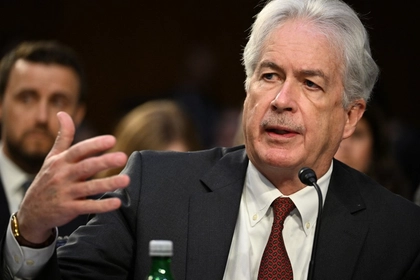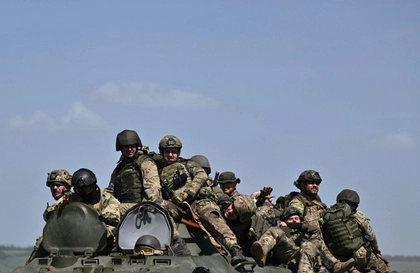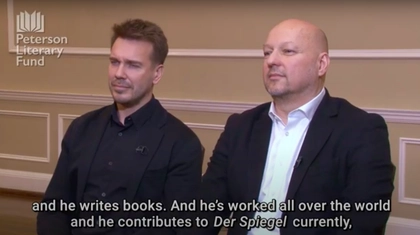Battle Line Update – Hardly Any Change
The front line between Ukraine and Russia was almost entirely stable this week. Indeed, the alterations seem if anything to be slowing down. The two most discussed areas in the Donbas over the last few months have been in front of the Ukrainian town of Chasiv Yar and in the “bulge” around Ocheretyne. Both of these areas have been the focus of a great number of Russian attacks for months now. Even here, the lines barely moved this week.
JOIN US ON TELEGRAM
Follow our coverage of the war on the @Kyivpost_official.
Here is the Chasiv Yar front line today:
Here it is a week ago – no noticeable change.
Even in what might be called the Ocheretyne “bulge” where the Russians have made numerous incremental (but very small) advances over the last two months, the line barely moved this week.
Here is the bulge this week:

Zelensky Meets CIA Director William Burns in Ukraine
And here it was a week ago – only very small alterations.
Let’s look back on the Ocheretyne bulge exactly four months ago (Feb. 22, 2024). This was just after the Ukrainians had to pull out of Avdiivka, which had been the focus of Russian attacks since October/November 2023. At that time, the line was, at its greatest extent, probably 15-20 kilometers (10-13 miles) from where it is now. Here is a map from then which you can compare to the maps of the bulge from today which are in the previous section.
As you can see, four months ago the line was about five kilometers to the east of Ocheretyne, and now it is about 5 kilometers to the west. As Russian advances towards Chasiv Yar have actually been far less –what we are looking at above is the greatest areas of Russian advance since the summer of 2022.
More than anything else this kind of advance reveals a few things. First and foremost, it is extremely hard to make anything but infantry-led, tiny advances, in this war. Such small advances mirror what happened last summer during the Ukrainian counteroffensive, which saw the Ukrainians advance similar distances (maybe even a little less) over three months that summer.
This is because of the fundamental advantages of defensive firepower (for now). The idea of a combined-arms advance of the type people were prophesying that Russia would do before Feb. 24, 2022, is based on the ability to mass and supply forces of armored vehicles, supported by fixed wing aircraft and mobile artillery which would allow them to advance through and around enemy forces making rapid and deep movements.
That form of war no longer exists for now. The range of defensive weapons, from accurate artillery, hand-helds, mines, and increasingly UAVs means that when attacking equipment reveals itself, it can be destroyed and disabled very quickly. We haven’t seen armored columns because whenever they try to be used in offensive roles they are located and hammered before they can advance.

It’s a shared lesson of the war.
Why then would anyone say that the last six months of this war shows that Ukraine can win? Well, it’s simple. It reveals that the Ukrainian military remains more flexible and efficient than the Russian, and if armed in the right way has the ability to do the kind of deeper damage to Russian forces needed to advance.
It’s important to remember that the Russian offensive of 2024 happened with Russia having arguably the greatest advantages in the war so far. They were:
- With the US cutting off aid to Ukraine on Jan. 1, 2024 (which was unexpected and unplanned for) the Ukrainians soon had to fight with a massive artillery disadvantage. There have been different numbers bandied about – often in the range of 10-1 to describe the Russian artillery advantage.
- At the same time that Ukraine had to expend a huge amount of its dwindling anti-air ammunition defending its own infrastructure, which was under very heavy attack in the late winter and spring. This was a perilous time for the Ukrainians, and the Russians made a series of mass attacks which did huge damage to Ukrainian power generation in particular. In other words, the Ukrainians had to spread some of their most advanced systems widely.
- The Russians were able to attack Ukrainian lines that were in no way built up and reinforced like the Russian lines were in 2023. When the Ukrainians launched their counteroffensive, they were attacking directly into prepared Russian defensive works, which made advancing very difficult. The Russians were attacking in 2024 into far less fortified lines – partly because the Ukrainians did not move fast enough and partly because the cut off of US aid put the Ukrainians in a far worse situation than expected.
- The Ukrainians were running shorter in soldier numbers precisely when the Russian Army was expanding significantly. Basically, the Russian attempts to generate troops throughout 2023 started paying dividends in early 2024. The Russians now reportedly have more than half a million soldiers in Ukraine (some reports have it over 600,000). Ukraine had not prepared for this well enough and was suffering a shortfall.
The failure of the Russians to make major advances with all these advantages and the success of the Ukrainians over Crimea show that Ukraine can win if armed properly.
So the Russians were in a position where they had a massive ammunition advantage, where the Ukrainians were having to devote much of their anti-air systems to domestic production, where the Russians were assaulting defensive lines which had not been prepared in depth and in which the Ukrainian forces were becoming increasingly out numbered.
All these advantages came together in the Russian Kharkiv counteroffensive –which the Russians were even able to organize in Russia itself, and thus launch with almost no disruption until Russian forces crossed the border. And yet, when the dust has settled, the Kharkiv Offensive is proving to be a problem more for Russia than Ukraine.
Kharkiv was no different than Chasiv Yar really. High losses for minimal gains – and the Russians are still struggling in Vovchansk as they have been struggling at Chasiv Yar.
At the same time as ground offensives are struggling to move, the Ukrainians are showing initiative and efficiency in a ranged campaign. Now armed with long-range ATACMS and developing more of their home-grown ranged systems, they have started doing great damage to Russian forces in Crimea, so much so that it has been argued that they are winning there.
I would argue that the failure of the Russians to make major advances with all these advantages and the success of the Ukrainians over Crimea show that Ukraine can win if armed properly.
However, any clear Ukrainian victory will require a massive effort, including providing Ukraine with the systems it needs to attack the Russians at range (think 50km-300km behind the lines – basically all of occupied Ukraine and over the border to the preparatory areas in Russia itself).
At the same time a great deal of support needs to go into helping Ukraine start building its own systems for ranged attack. The Ukrainians have shown some great adaptation in this area, particularly when it comes to UAVs and sea drones – they need the ability to build the mass in these areas where it is lacking.
Finally, as part of Ukrainian production, there needs now to be a major infusion of anti-air weaponry into Ukraine to protect what is left of Ukrainian power generation. The Russians great success of the last few months, as I’ve argued, is not on the battlefield, it’s their strategic air campaign. There was another large Russian attack last night. In starving Ukraine of anti-air ammo, the US helped the Russians destroy of Ukrainian power. That must end.
It won’t be easy, and actually the signs are (at best) mixed. Ukraine clearly doesn’t have enough ATACMS and the Germans have not sent valuable ranged systems such as Taurus. Support for Ukrainian ranged production still seems limited. Only when it comes to rushing anti-air systems to Ukraine have there been some positive signs this week.
The alternative is to arm Ukraine to continue exacting a heavy toll on the Russians (the casualties they are inflicting are immense) but only providing them mass to fight on the front lines. If that is the case, it’s hard to see Ukraine doing anything more but struggling with high losses at it attacks Russian forces directly.
If we have learned anything over the last year – that is not a recipe for success.
So, the Ukrainian military is still the more flexible, resourceful and efficient. It can win the war. However, to do so it must be armed properly. As of now – that does not seem to be happening (to the degree that it must).
This article has been republished with the author’s permission. See the original here.
The views expressed are the author’s and not necessarily of Kyiv Post.
You can also highlight the text and press Ctrl + Enter











